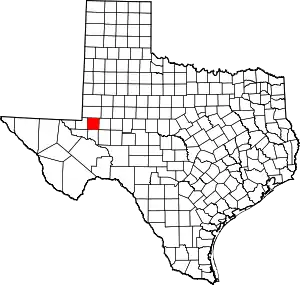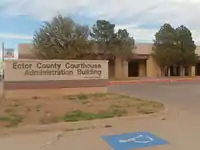Ector County, Texas
Ector County is a county located in the U.S. state of Texas. In the 2010 census, its population was 137,130.[1] As of 2019, its population is 166,223. Its county seat is Odessa.[2] The county was founded in 1887 and organized in 1891.[3] It is named for Mathew Ector,[4] a Confederate general in the American Civil War.
Ector County | |
|---|---|
_DSCN1270.JPG.webp) Ector County Courthouse in Odessa | |
 Location within the U.S. state of Texas | |
 Texas's location within the U.S. | |
| Coordinates: 31°52′N 102°32′W | |
| Country | |
| State | |
| Founded | 1891 |
| Named for | Mathew Ector |
| Seat | Odessa |
| Largest city | Odessa |
| Area | |
| • Total | 902 sq mi (2,340 km2) |
| • Land | 898 sq mi (2,330 km2) |
| • Water | 4.1 sq mi (11 km2) 0.5%% |
| Population (2010) | |
| • Total | 137,130 |
| • Density | 153/sq mi (59/km2) |
| Time zone | UTC−6 (Central) |
| • Summer (DST) | UTC−5 (CDT) |
| Congressional district | 11th |
| Website | www |

Ector County comprises the Odessa, Texas, metropolitan statistical area, which is included in the Midland–Odessa combined statistical area.
Geography
According to the U.S. Census Bureau, the county has a total area of 902 sq mi (2,340 km2), of which 898 sq mi (2,330 km2) are land and 4.1 sq mi (11 km2) (0.5%) are covered by water.[5] Ector County has an average rainfall of about 14 in per year and a warm, sunny, semiarid climate. Most of the county is relatively flat, with small areas of slightly rolling terrain. The area is known for its stark landscape. The few naturally occurring trees are mostly mesquite trees, which more resemble large bushes.
Major highways
Adjacent counties
- Andrews County (north)
- Midland County (east)
- Upton County (southeast)
- Crane County (south)
- Ward County (southwest)
- Winkler County (west)
Demographics
| Historical population | |||
|---|---|---|---|
| Census | Pop. | %± | |
| 1890 | 224 | — | |
| 1900 | 381 | 70.1% | |
| 1910 | 1,178 | 209.2% | |
| 1920 | 760 | −35.5% | |
| 1930 | 3,958 | 420.8% | |
| 1940 | 15,051 | 280.3% | |
| 1950 | 42,102 | 179.7% | |
| 1960 | 90,995 | 116.1% | |
| 1970 | 91,805 | 0.9% | |
| 1980 | 115,374 | 25.7% | |
| 1990 | 118,934 | 3.1% | |
| 2000 | 121,123 | 1.8% | |
| 2010 | 137,130 | 13.2% | |
| 2019 (est.) | 166,223 | [6] | 21.2% |
| U.S. Decennial Census[7] 1850–2010[8] 2010–2019[1] | |||
As of the census[9] of 2000, 121,123 people, 43,846 households, and 31,700 families resided in the county. The population density was 134 people per square mile (52/km2). The 49,500 housing units averaged 55 per square mile (21/km2). The racial makeup of the county was 73.69% White, 4.61% African American, 0.83% Native American, 0.64% Asian, 0.04% Pacific Islander, 17.38% from other races, and 2.81% from two or more races. About 42.36% of the population was Hispanic or Latino of any race.
Of the 43,846 households, 38.90% had children under the age of 18 living with them, 54.10% were married couples living together, 13.70% had a female householder with no husband present, and 27.70% were not families. About 24.00% of all households was made up of individuals, and 8.90% had someone living alone who was 65 years of age or older. The average household size was 2.72 and the average family size was 3.25.
In the county, the population was distributed as 30.40% under the age of 18, 10.50% from 18 to 24, 27.90% from 25 to 44, 20.20% from 45 to 64, and 10.90% who were 65 years of age or older. The median age was 32 years. For every 100 females, there were 94.70 males. For every 100 females age 18 and over, there were 90.90 males.
The median income for a household in the county was $31,152, and for a family was $36,369. Males had a median income of $30,632 versus $21,317 for females. The per capita income for the county was $15,031. About 16.10% of families and 18.70% of the population were below the poverty line, including 23.90% of those under age 18 and 14.30% of those age 65 or over.
Communities
Census-designated places
Unincorporated communities
Ghost towns
- Arcade
- Badger
- Douro
- Judkins
- Metz
- North Cowden
- Prairie Home
- Scharbauer City
- Smith Chapel
- Turnbaugh Corner
Politics
| Year | Republican | Democratic | Third parties |
|---|---|---|---|
| 2020 | 73.3% 32,697 | 25.5% 11,367 | 1.2% 527 |
| 2016 | 68.5% 25,020 | 28.1% 10,249 | 3.5% 1,261 |
| 2012 | 73.9% 24,010 | 25.0% 8,118 | 1.2% 385 |
| 2008 | 73.5% 26,199 | 25.6% 9,123 | 0.9% 329 |
| 2004 | 75.7% 27,502 | 23.6% 8,579 | 0.6% 229 |
| 2000 | 69.6% 22,893 | 28.7% 9,425 | 1.8% 583 |
| 1996 | 54.3% 17,746 | 36.8% 12,017 | 8.9% 2,923 |
| 1992 | 50.4% 18,161 | 30.9% 11,130 | 18.8% 6,782 |
| 1988 | 67.8% 23,155 | 31.7% 10,825 | 0.5% 172 |
| 1984 | 77.4% 31,228 | 22.1% 8,913 | 0.5% 201 |
| 1980 | 72.4% 26,188 | 25.1% 9,069 | 2.6% 922 |
| 1976 | 62.6% 18,973 | 35.6% 10,802 | 1.8% 553 |
| 1972 | 79.3% 21,386 | 20.2% 5,449 | 0.5% 125 |
| 1968 | 43.0% 10,557 | 21.7% 5,312 | 35.3% 8,671 |
| 1964 | 51.4% 11,497 | 48.4% 10,826 | 0.3% 63 |
| 1960 | 53.9% 11,145 | 43.5% 8,996 | 2.6% 531 |
| 1956 | 62.4% 8,805 | 36.2% 5,109 | 1.4% 194 |
| 1952 | 61.0% 8,259 | 38.9% 5,270 | 0.1% 8 |
| 1948 | 20.1% 1,145 | 75.6% 4,305 | 4.3% 244 |
| 1944 | 14.0% 432 | 73.3% 2,265 | 12.8% 394 |
| 1940 | 13.9% 451 | 85.9% 2,783 | 0.2% 5 |
| 1936 | 8.9% 81 | 89.9% 816 | 1.2% 11 |
| 1932 | 6.2% 37 | 89.1% 530 | 4.7% 28 |
| 1928 | 52.7% 168 | 47.3% 151 | |
| 1924 | 7.7% 12 | 89.0% 138 | 3.2% 5 |
| 1920 | 18.4% 23 | 80.0% 100 | 1.6% 2 |
| 1916 | 1.6% 2 | 98.4% 120 | |
| 1912 | 3.1% 3 | 92.7% 89 | 4.2% 4 |
See also
References
- "Ector County Profile". Archived from the original on September 18, 2015. Retrieved January 21, 2017.
- "Find a County". National Association of Counties. Archived from the original on 2012-07-12. Retrieved 2011-06-07.
- "Texas: Individual County Chronologies". Texas Atlas of Historical County Boundaries. The Newberry Library. 2008. Retrieved May 23, 2015.
- Gannett, Henry (1905). The Origin of Certain Place Names in the United States. Govt. Print. Off. pp. 114.
- "2010 Census Gazetteer Files". United States Census Bureau. August 22, 2012. Retrieved April 26, 2015.
- "Population and Housing Unit Estimates". United States Census Bureau. May 24, 2020. Retrieved May 27, 2020.
- "U.S. Decennial Census". United States Census Bureau. Retrieved April 26, 2015.
- "Texas Almanac: Population History of Counties from 1850–2010" (PDF). Texas Almanac. Retrieved April 26, 2015.
- "U.S. Census website". United States Census Bureau. Retrieved 2011-05-14.
- Leip, David. "Dave Leip's Atlas of U.S. Presidential Elections". uselectionatlas.org. Retrieved 2018-07-22.

